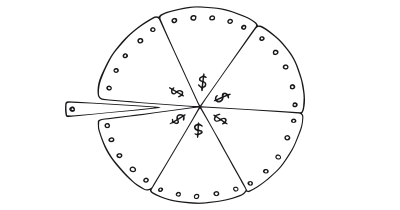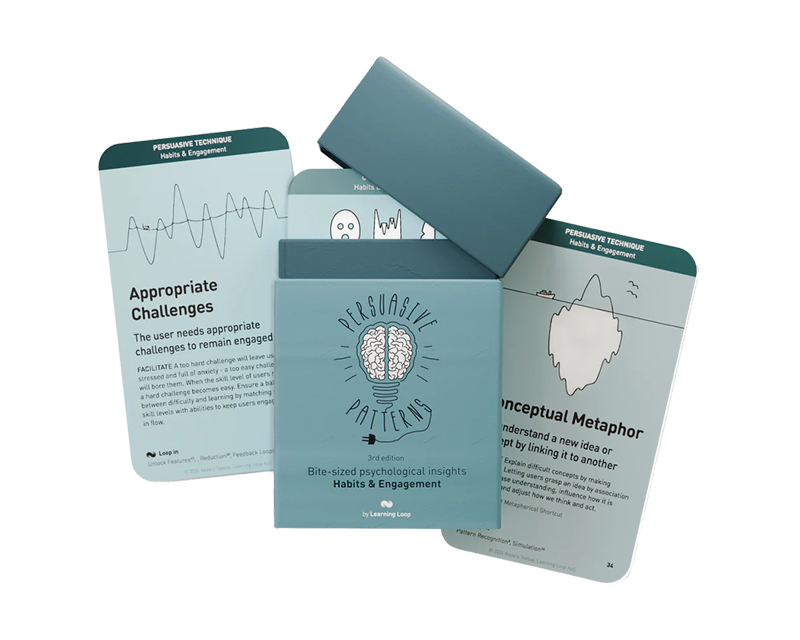Positive Mimicry refers to the natural inclination of individuals to mirror or replicate behaviors, emotions, or actions they perceive as beneficial or positive in others.
In a small community, there’s a local park where many residents enjoy morning walks. One individual started a practice of picking up litter during their walks, placing the waste in a bag they carried. Over time, other regular park-goers noticed this behavior. Without any explicit communication, a few of them began to mimic the act, bringing along their own bags and collecting trash as they walked. The sight of one person’s act of cleanliness, subtly and without any force, influenced others to adopt a similar positive behavior.
Consider a new digital drawing app that a user has just installed. During the onboarding process, the app showcases short looping videos of users effortlessly creating art, using specific tools, and techniques within the app. As the new user watches, they see the ease with which certain tasks are done and, almost instinctively, they begin to mimic those actions. The app’s design, by subtly showing how others navigate and use its features, encourages the user to adopt those behaviors, ensuring a smoother onboarding and learning experience.
The study
A study by Jacob, et. al. (2011) reveals that when retail salespeople mimic their customers, it leads to a higher sales rate, greater compliance to the sales clerk’s suggestions during the selling process, and more positive evaluations of both the sales clerks and the store. Specifically, results in the study showed that mimicry was associated with a higher sales rate. This suggests that the art of selling isn’t just about presenting a product; it’s about forging a genuine connection through the power of positive mimicry, enhancing the overall selling experience and outcome.
Jacob, C., Guéguen, N., Martin, A., & Boulbry, G. (2011). Retail salespeople’s mimicry of customers: Effects on consumer behavior. Journal of Retailing and Consumer Services, 18(5), 381-388
The main psychological principle behind Positive Mimicry is the inherent human need for social cohesion and acceptance. When we mimic or are mimicked by others, it creates a sense of belonging, validation, and mutual understanding, fostering positive feelings and smoother interactions. Mimicry often occurring outside our conscious awareness, influences our perceptions, feelings, and actions.
Positive Mimicry is grounded in our evolutionary predisposition to adopt behaviors that have proven advantageous or rewarding for others in our environment. By mimicking such behaviors, individuals often hope to achieve similar positive outcomes or be perceived in a more favorable light. This principle operates both on a conscious and subconscious level, influencing a wide range of decisions and actions. While it can lead to constructive outcomes like learning and cooperation, it’s essential to recognize the boundaries and ensure it’s applied authentically and ethically.
Designing products using Positive Mimicry
While positive mimicry has its advantages, it’s crucial to be cautious of over-imitation. Excessive or overt mimicry might come off as inauthentic or even creepy to the user, leading to mistrust. Moreover, relying solely on mimicry without considering the broader context or individual user needs can result in a disjointed experience. It’s also essential to remember that while mimicry can enhance familiarity, innovation should not be sidelined. Striking a balance between familiar (mimicked) patterns and novel features is key to a product’s success and user satisfaction.
The principle of positive mimicry, rooted in the human tendency to feel more comfortable with the familiar, can be a powerful tool in product design. By echoing users’ behaviors, choices, and preferences, designers can create a more intuitive and personalized user experience.
An example is adaptive learning platforms adjusting the learning content based on a user’s performance, mimicking the tailored approach of a personal tutor. When a user struggles with certain topics, the system will offer more exercises on that subject, ensuring that the content aligns closely with the learner’s needs.
Similarly, chatbots that learn from past interactions can offer a more personalized service. Instead of providing generic responses, these chatbots can recall previous interactions, mimicking the continuity of conversation you’d expect from human-to-human dialogues. This mirroring not only improves the user’s experience but also fosters trust and rapport.
The aim is to create a sense of familiarity without coming across as intrusive. Ethically, it’s essential to ensure that users are aware of and comfortable with how their data is being used for mimicry. Transparent communication about data usage, along with easy-to-access controls for users to manage their data, are fundamental.
Common mistakes include:
- Overpersonalization
While mimicking user behavior can create a tailored experience, taking it to an extreme might make users feel their privacy is invaded. It’s crucial to ensure that mimicry does not become surveillance. - Assumption Errors
Just because a user behaved a certain way once doesn’t mean that behavior is a permanent preference. Relying too heavily on a single data point can lead to incorrect assumptions about user preferences. - Lack of Transparency
Mimicry, by its nature, involves using data about the user. Not being transparent about how this data is collected, stored, and used can lead to trust issues and potential ethical concerns. - Over-reliance on Automation
While AI and machine learning can be useful tools for implementing mimicry, it’s essential to have human oversight. Sometimes, the nuances of human behavior can be misinterpreted by algorithms.
Ethical recommendations
When platforms excessively mirror a user’s behavior or preferences, they risk creating a narrowing echo chamber. Such environments might limit users’ exposure to diverse content or experiences, potentially hindering personal growth and inadvertently reinforcing existing biases.
Moreover, the foundation of mimicry is built on understanding and replicating user behavior, which invariably involves the collection and analysis of user data. Without explicit and transparent data collection policies, this opens a Pandora’s box of privacy concerns, potentially leading to unauthorized use or even misuse of personal information.
To ethically apply the principle positive mimicry, a few guiding principles are crucial:
- Transparency
Always be transparent about how user data is being used to create a mimicked experience. Providing clear, understandable information about data collection practices will foster trust. - Limit data collection
Only collect the data that is necessary for the mimicking process. Avoid storing excessive amounts of personal data and regularly purge unnecessary information. - Provide opt-out options
Allow users the choice to opt-out of certain mimicking features if they’re uncomfortable with the level of personalization or if they wish to explore content outside of their typical preferences. - Avoid reinforcing negative behaviors
Positive mimicry can inadvertently reinforce harmful or negative behaviors if not carefully managed. For instance, if a user frequently visits unhealthy food recipes, a health app shouldn’t keep suggesting similar recipes without occasionally introducing healthier alternatives. - Data sensitivity
Some data might be more sensitive than others. For instance, mirroring browsing habits related to medical conditions or personal challenges can be seen as invasive. Designers should be discerning about which behaviors are mirrored and ensure they don’t cross personal boundaries.
Real life Positive Mimicry examples
Duolingo
Duolingo introduced chatbots to help learners practice real-life conversation without the pressure of speaking to a human. The chatbots mimic human conversational patterns and adapt their complexity based on the user’s proficiency level. This mimicry provides users with a simulated environment that mirrors real conversational experiences, enhancing the learning process.
ChatGPT
ChatGPT, developed by OpenAI, is a chatbot that’s been trained on various internet conversations. It doesn’t just respond to user queries; it adapts its responses based on the context provided by the user, mimicking a more human-like conversation. This mimicry, where the bot seems to “understand” and “adapt” to the conversation, enhances user engagement.
Grammarly
As users continue to use this writing assistant tool, it learns their writing style and starts making recommendations that align more closely with individual user preferences, thereby mimicking the user’s natural writing style.
Trigger Questions
- What beneficial behaviors or actions do I want users to mimic within the design?
- How can I incorporate elements that showcase others benefiting from the desired behavior, encouraging mimicry?
- Does the mimicry element come off as genuine and natural, or does it risk feeling forced or inauthentic?
- How can I strike a balance between familiar (mimicked) patterns and innovative features to ensure a seamless user experience?
- Am I being transparent about how user data is utilized for mimicry, and have I provided opt-out options?
- How can I continuously gather feedback to ensure the mimicry applied remains beneficial and doesn't inadvertently reinforce negative behaviors?
Pairings
Positive Mimicry + Social Proof
Integrating the power of social validation with mimicry can enhance the persuasiveness of a product. For instance, a fitness app could use positive mimicry by adapting workout routines based on user preferences, while simultaneously highlighting popular workouts among peers (social proof). This combination assures users that not only is the app personalized for them, but it’s also aligned with what’s popular or effective for others.

We learn by comparing our behavior with the actions of others

We assume the actions of others in new or unfamiliar situations
Positive Mimicry + Commitment & Consistency
Once users make a small commitment, they’re more likely to act consistently with that decision. If a platform mirrors this initial commitment (e.g., a preference set in the beginning), it reinforces their decision and drives further engagement. An e-commerce site, for example, might mimic a user’s style preferences set during an initial quiz, consistently highlighting products that align with that style throughout the shopping experience.

We learn by comparing our behavior with the actions of others

We want to appear consistent with our stated beliefs and prior actions
Positive Mimicry + Triggers
By pairing timely prompts (triggers) with positive mimicry, platforms can encourage desired behaviors. A language learning app, for instance, might send reminders (triggers) for lessons based on a user’s past activity times, mimicking their natural schedule.

We learn by comparing our behavior with the actions of others

Place cues on our regular paths to remind and motivate us to take action
A brainstorming tool packed with tactics from psychology that will help you build lasting habits, facilitate behavioral commitment, build lasting habits, and understand the human mind. It is presented in a manner easily referenced and used as a brainstorming tool.
Get your deck!- Mimicry: Facts and fiction by Hess, Philippot & Blairy
- Emotional mimicry in social context: The case of disgust and pride by Fischer, et. al.
- Jacob, C., Guéguen, N., Martin, A., & Boulbry, G. (2011). Retail salespeople's mimicry of customers: Effects on consumer behavior. Journal of Retailing and Consumer Services, 18(5), 381-388
- Chartrand, T. L., & Bargh, J. A. (1999). The chameleon effect: The perception–behavior link and social interaction. Journal of Personality and Social Psychology, 76(6), 893–910.
- Lakin, J. L., Jefferis, V. E., Cheng, C. M., & Chartrand, T. L. (2003). The chameleon effect as social glue: Evidence for the evolutionary significance of nonconscious mimicry. Journal of Nonverbal Behavior, 27(3), 145–162.
- van Baaren, R. B., Holland, R. W., Kawakami, K., & Van Knippenberg, A. (2004). Mimicry and prosocial behavior. Psychological Science, 15(1), 71–74.
- Hess, U., Philippot, P., & Blairy, S. (1999). Mimicry: Facts and fiction. In P. Philippot, R. S. Feldman, & E. J. Coats (Eds.), The social context of nonverbal behavior (pp. 213–241). Cambridge University Press
- Agneta H. Fischer, Daniela Becker and Lotte Veenstra (2012), Emotional mimicry in social context: the case of disgust and pride, Department of Social Psychology, University of Amsterdam

